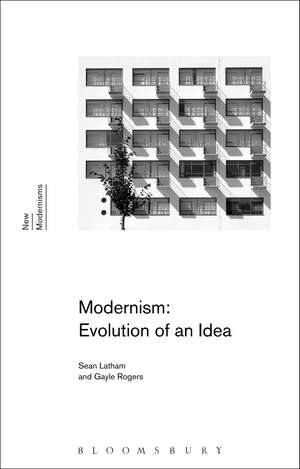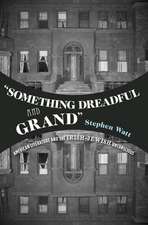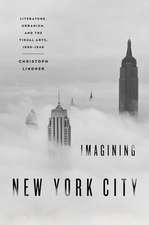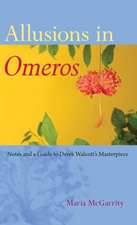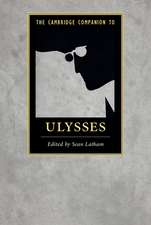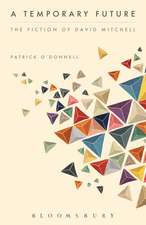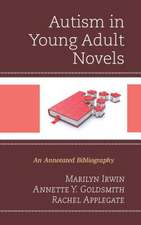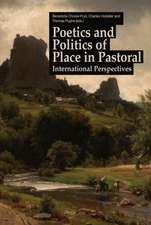Modernism: Evolution of an Idea: New Modernisms
Autor Professor Sean Latham, Dr Gayle Rogersen Limba Engleză Paperback – 21 oct 2015
| Toate formatele și edițiile | Preț | Express |
|---|---|---|
| Paperback (1) | 185.93 lei 6-8 săpt. | |
| Bloomsbury Publishing – 21 oct 2015 | 185.93 lei 6-8 săpt. | |
| Hardback (1) | 597.37 lei 6-8 săpt. | |
| Bloomsbury Publishing – 21 oct 2015 | 597.37 lei 6-8 săpt. |
Preț: 185.93 lei
Preț vechi: 215.02 lei
-14% Nou
Puncte Express: 279
Preț estimativ în valută:
35.58€ • 38.04$ • 29.66£
35.58€ • 38.04$ • 29.66£
Carte tipărită la comandă
Livrare economică 18 aprilie-02 mai
Preluare comenzi: 021 569.72.76
Specificații
ISBN-13: 9781472523778
ISBN-10: 1472523776
Pagini: 272
Ilustrații: 3 b/w illustrations
Dimensiuni: 138 x 216 x 18 mm
Greutate: 0.39 kg
Editura: Bloomsbury Publishing
Colecția Bloomsbury Academic
Seria New Modernisms
Locul publicării:London, United Kingdom
ISBN-10: 1472523776
Pagini: 272
Ilustrații: 3 b/w illustrations
Dimensiuni: 138 x 216 x 18 mm
Greutate: 0.39 kg
Editura: Bloomsbury Publishing
Colecția Bloomsbury Academic
Seria New Modernisms
Locul publicării:London, United Kingdom
Caracteristici
An accessible one-volume history of modernist studies from its earliest critics to the latest approaches
Notă biografică
Sean Latham is Pauline Walter Endowed Chair of English and Comparative Literature and director of the Oklahoma Center for the Humanities. He is editor of the James Joyce Quarterly, co-founder of the Modernist Journals Project. His teaching and research focuses on modernist studies, James Joyce, periodicals, media theory, and the digital humanities. He is the author or editor of nine books including "Am I a Snob?": Modernism and the Novel (Cornell University Press, 2003), The Art of Scandal: Modernism, Libel Law, and the Roman à Clef (New York: Oxford University Press, 2009), and The Little Review Ulysses (New York: Yale University Press, 2015).Gayle Rogers is Professor of English at the University of Pittsburgh, USA. He works primarily on global modernisms, literary history, translation, comparative literature, and periodicals. His publications include Incomparable Empires: Modernism and the Translation of Spanish and American Literature (2016), Modernism and the New Spain: Britain, Cosmopolitan Europe, and Literary History (2012), and a number of works in PMLA, Modernism/Modernity, Comparative Literature, NOVEL, Journal of Modern Literature, James Joyce Quarterly, The Oxford Handbook of Global Modernisms, Journal of Modern Periodical Studies, Modern Fiction Studies, Revista de Estudios Orteguianos, and 100 Escritores del siglo XX.
Cuprins
Introduction: Is there a there there? Chapter 1: The Emergence of "Modernism" Chapter 2: Consolidation Chapter 3: Iron Filings Chapter 4: Networks Glossary Critical Bibliography Works Cited
Recenzii
The field of modernist studies consists in large part of debates over how the field should be defined.[This book] is an elegant, lucid, and helpful introduction to the field of modernist studies. Yet- and to its very great credit-it does not shy away from the definitional problems I have described but weaves them into a clear articulation of the difficulties and contradictions at the heart of modernism as a project and as a field.
Highly recommended. Lower-division undergraduates through faculty; general readers.
Sean Latham and Gayle Rogers offer a perfectly timed history . that will be of immediate interest to anyone who studies modernism and twentieth-century literary history . They offer a succinct, often fascinating account of how and why it has become impossible to offer a tidy definition of modernism . The picture that emerges from Latham and Rogers's narrative is one of incredible complexity and variety . With this condensed, lucid, compelling history, Latham and Rogers enable their readers . to learn what has been accomplished in the last century of interrogating modernism and then discover what tasks remain. Because of the significant critical generosity that underwrites this study, we can conclude, with Pound, Latham, and Rogers, that there is still much to do.
An ambitious project . tracing the evolution of the term "modernism" from a cultural buzzword to a consolidated . signifier of a particular set of artistic conventions and works . It would not be surprising to see this study on any modernist's bookshelf.
An excellent account of the development of the idea of Modernism, with a useful glossary and a very good critical bibliography.
The writers display deep and wide expertise as they move nimbly over more than a century's worth of fraught material. They offer students and colleagues a thorough overview of the debates that have constituted the field they call "modernist studies."
An engaging introduction to the fraught history of modernism as a critical and aesthetic category, the book makes a substantive case for the lability of its subject ... This is disciplinary historiography at its most lucid, and the narrative weaves introduce readers to or reminds them of an impressive number of arguments without ever feeling rushed, over-stuffed, or, most importantly, tangential ... Latham and Rogers append an extensive critical bibliography of significant works in modernist studies, which should prove invaluable to students and early researchers looking for direction in navigating such a diverse field. The detail of this apparatus speaks to the utility of Modernism as a whole, a book that should become a staple in modernist classrooms and dissertation reading lists for the foreseeable future.
Latham and Rogers succeed in providing in the four chapters of their book an excellent introduction to the shifting conceptualizations and criticisms of modernism in literary and artistic debates.
Admirably, the authors manage to produce not only a survey of the term's complex trajectory, but one laced with important critical contentions ... Latham and Rogers's analyses make their book far more than just an introductory survey.
Highly recommended. Lower-division undergraduates through faculty; general readers.
Sean Latham and Gayle Rogers offer a perfectly timed history . that will be of immediate interest to anyone who studies modernism and twentieth-century literary history . They offer a succinct, often fascinating account of how and why it has become impossible to offer a tidy definition of modernism . The picture that emerges from Latham and Rogers's narrative is one of incredible complexity and variety . With this condensed, lucid, compelling history, Latham and Rogers enable their readers . to learn what has been accomplished in the last century of interrogating modernism and then discover what tasks remain. Because of the significant critical generosity that underwrites this study, we can conclude, with Pound, Latham, and Rogers, that there is still much to do.
An ambitious project . tracing the evolution of the term "modernism" from a cultural buzzword to a consolidated . signifier of a particular set of artistic conventions and works . It would not be surprising to see this study on any modernist's bookshelf.
An excellent account of the development of the idea of Modernism, with a useful glossary and a very good critical bibliography.
The writers display deep and wide expertise as they move nimbly over more than a century's worth of fraught material. They offer students and colleagues a thorough overview of the debates that have constituted the field they call "modernist studies."
An engaging introduction to the fraught history of modernism as a critical and aesthetic category, the book makes a substantive case for the lability of its subject ... This is disciplinary historiography at its most lucid, and the narrative weaves introduce readers to or reminds them of an impressive number of arguments without ever feeling rushed, over-stuffed, or, most importantly, tangential ... Latham and Rogers append an extensive critical bibliography of significant works in modernist studies, which should prove invaluable to students and early researchers looking for direction in navigating such a diverse field. The detail of this apparatus speaks to the utility of Modernism as a whole, a book that should become a staple in modernist classrooms and dissertation reading lists for the foreseeable future.
Latham and Rogers succeed in providing in the four chapters of their book an excellent introduction to the shifting conceptualizations and criticisms of modernism in literary and artistic debates.
Admirably, the authors manage to produce not only a survey of the term's complex trajectory, but one laced with important critical contentions ... Latham and Rogers's analyses make their book far more than just an introductory survey.
